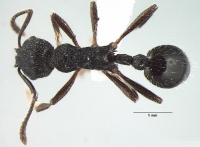Myrmica adrijae
| Myrmica adrijae | |
|---|---|

| |
| Scientific classification | |
| Kingdom: | Animalia |
| Phylum: | Arthropoda |
| Class: | Insecta |
| Order: | Hymenoptera |
| Family: | Formicidae |
| Subfamily: | Myrmicinae |
| Tribe: | Myrmicini |
| Genus: | Myrmica |
| Species: | M. adrijae |
| Binomial name | |
| Myrmica adrijae Bharti, 2012 | |
Myrmica adrijae was collected from a nest under stone on a mountain slope with a patchy Cedrus forest having grass cover. The nest was small with 6 workers. The recorded nest temperature at the site was 20°C. (Bharti, 2012; Bharti et al., 2016).
Identification
Bharti (2012) - Myrmica adrijae belongs to the smythiesii species group based on the following combination of characters: frontal carinae merge with the rugae that surround antennal sockets. Frons wide and frontal lobes not extended. Scape very smoothly curved at the base, not angled and with no trace of lobe or carina. Anterior clypeal margin is distinctly prominent, without a medial notch.
From the three central Asian mountain species of the smythiesii species group, M. adrijae is clearly separated by the following characters: head dorsum and sides with reticulate sculpture, promesonotum with irregular reticulate sculpture with few transverse rugae; metanotal groove longitudinally rugose; anterior half of propodeum transversally rugose dorsally, posterior part irregularly striate. In two species, viz., Myrmica smythiesii and Myrmica fortior, the head dorsum is longitudinally striate without reticulate sculpture and whole alitrunk also longitudinally rugose except for reticulations restricted to promesonotum, without a trace of transverse rugosity; finally Myrmica wittmeri differs well from this species by the presence of strongly reduced sculpture on head and alitrunk. In summary M. adrijae differs from the other species of the smythiesii group by its quite unique sculpture of head and alitrunk.
Distribution
Latitudinal Distribution Pattern
Latitudinal Range: 32.189° to 32.189°.
| North Temperate |
North Subtropical |
Tropical | South Subtropical |
South Temperate |
- Source: AntMaps
Distribution based on Regional Taxon Lists
Oriental Region: India (type locality).
Distribution based on AntMaps
Distribution based on AntWeb specimens
Check data from AntWeb
Countries Occupied
| Number of countries occupied by this species based on AntWiki Regional Taxon Lists. In general, fewer countries occupied indicates a narrower range, while more countries indicates a more widespread species. |

|
Estimated Abundance
| Relative abundance based on number of AntMaps records per species (this species within the purple bar). Fewer records (to the left) indicates a less abundant/encountered species while more records (to the right) indicates more abundant/encountered species. |

|
Biology
Castes
Known only from the worker caste.
Nomenclature
The following information is derived from Barry Bolton's Online Catalogue of the Ants of the World.
- adrijae. Myrmica adrijae Bharti, 2012: 10, figs. 1-3 (w.) INDIA.
Unless otherwise noted the text for the remainder of this section is reported from the publication that includes the original description.
Description
Worker
Head. Head much longer than broad, sides parallel, occipital margin straight; mandibles with 8–9 teeth (apical and preapical one largest), longitudinally rugulose and with punctures; clypeus convex, longitudinally rugulose, anterior clypeal margin prominent, very narrowly rounded medially and extending over mandibles, space between rugae smooth and shiny; frontal triangle highly polished, smooth and shining; frontal carinae short, curve outwards to merge with rugae that surround the antennal sockets; frontal lobes partially cover condylar bulb; frons wide and frontal lobes not extended; antennae 12 segmented, apical 4 segments forming club, apical 3 segments densely punctated and following segments minutely punctated, scape slender, narrow, weakly curved at base without any trace of lobe or carina, widening towards apex, just extending beyond the upper margin of head, antennae with oblique short hairs; eyes almost at midlength of head; head dorsum and sides with reticulate sculpture, punctated except for small area behind frontal triangle up to the level of eyes longitudinally rugose; head with numerous short suberect hairs and few long hairs combined together.
Alitrunk, petiole and postpetiole. Alitrunk dorsum feebly convex; promesonotum with weak suture and irregular reticulate sculpture with few very wide transverse reticulations; mesonotum dorsally slightly depressed; metanotal groove broad, deep, longitudinally rugose; anterior half of propodeum transversally rugose dorsally, posterior part irregularly rugose, propodeal spines long, pointed, widened at base, projected backward, divergent; propodeal lobes rounded apically; sides of alitrunk with longitudinal striations except anterior part of pronotum with reticulations; tibiae of hind and middle legs with well developed pectinate spur; petiole longer than broad, with short anterior peduncle with a tooth like subpetiolar process, node obliquely truncate, shagreenate, punctated; postpetiole almost as broad as long, punctated and shagreenate; promesonotum with long erect to suberect hairs; metanotal groove with long hairs; propodeum with one pair of short hairs and minute pubescence; petiole and postpetiole equipped with long hairs which are directed upwards and backwards.
Gaster. Gaster highly polished and shiny; tergites and sternites with numerous long suberect hairs and with pubescence between them.
Coloration. Whole body blackish brown, mandibles, antennae and legs brown.
Type Material
Holotype: worker, India, Himachal Pradesh, Kothi, 2479 meters above msl, 29.vi.1999 (H. Bharti coll.,code = 193) (Punjabi University Ant Collection). Paratypes: 5 workers: collected from the same nest (The Natural History Museum; PUAC). GPS coordinates 32.1890°N–77.1170°E.
Etymology
Species has been named after Adrija, younger daughter of author; as she was always accompanying the author in recent times to collect ants.
References
- Bharti, H. 2012. Two new species of the genus Myrmica (Hymenoptera: Formicidae: Myrmicinae) from the Himalaya. Tijdschrift voor Entomologie, 155, 9–14.
- Bharti, H., Sasi, S., Radchenko, A. 2016. Biogeography and ecology of Myrmica species (Formicidae: Myrmicinae) in Himalayan regions. Sociobiology 63, 956-975 (DOI 10.13102/sociobiology.v63i3.1145).

